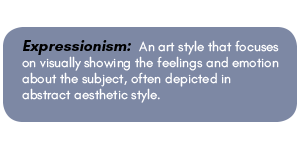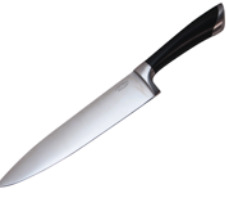2.1 GERMAN EXPRESSIONISM
German Expressionism
Explore the movement that laid the groundwork for future film genres.
German expressionism is one of the first major film movements in the history of film. In other words, it is one of the first set of films that are recognised to have a collective influence on filmmakers. The nature of a movement is that the filmmakers in a particular place and time created similar art. This means that the films have artistic value when looked at together as well as individually. The power of their meaning is increased by the fact that they are part of a group. The reason why so many films are created with the same ideas, themes, stories, and visual language is because they are influenced by their time and place.
In this chapter, we will visit 1920s Germany. The Weimar Republic, in order to discover more about the situation that gave rise to German expressionism. We will look at why it’s called “Expressionism”, a name for an artistic style that was emerging in popularity, contrary to popular impressionistic art at the time. We will also look at the context in relation to the events of World War I. Western Europe had never experienced such destruction. The German Empire had been defeated and change was on the horizon. Cinema, a medium based on the manipulation of light, would provide an escape from the darkness and rubble of World War I and forever change and inspire the filmmaking world.
THE WEIMAR REPUBLIC
In 1919 after the First World War, Germany was devastated; its infrastructure and economy lay in ruins. The Weimar government was instated in Germany as part of the agreement at the Treaty of Versailles. The Weimar Republic was a dramatic change in Germany and enabled a new start and total reversal in culture.
Before the war, Germans had benefited from the advances of the industrial revolution and the enterprises that brought with it, including film. Filmmaking was a growing industry but until that time, cinema-goers in Germany had access to a market that was mainly saturated with foreign films such as those being made in the USA. From 1910-1914, In an attempt to recapture local audiences, many German filmmakers focused on more nationalistic themes, such as German social achievements, industrial and technological advancements and films that promoted German culture.
During the war, Germany’s economy was heavily focused on the production of military equipment and the survival of their nation. Imported films were blocked and the production of film was run by the government-controlled Aktiengesellschaft (UFA).
In the aftermath of the war, Germany was left with many reparations to make for the damages not just in Germany, but across all of Europe. The Weimar government obtained large loans from countries such as the USA that allowed the rebuilding of the ruined cities and investment in the economy. This lead to a period of prosperity from 1924 to 1929.
SOCIO-POLITICAL CONTEXT
Cinema was a new and popular pastime and to further promote its growth, the Weimar Republic ceased the government ownership of the film industry. The censorship that existed during the wartime era and before was removed. Artists were stimulated to new levels of creativity.
The German people rejected the values that lead to the events of the First World War. Society became more liberal, both as a way to try something different to the conservative culture that existed before and also to assist them in dealing with the consequences and horrors wrought by the war. German filmmakers aimed to empathise with their audience’s reality, drawing from the darkness that still existed within society at that time.
It was a unique socio-political context at the time and one that resulted Berlin becoming one of the artistic capitals of the world. There was an intellectual curiosity in the German people that was born from their new life as survivors of the Great War, the biggest conflict in history to date.
From 1924, the art, theatre and film industries began to boom. With quotas still being placed on foreign films, restricting the number of films that could be shown from outside of Germany, the German filmmakers had the market to themselves. The early 1920s saw huge growth in the output of German films. Thousands of feature films were produced and, due to the fall in the German Currency, they were able to export their creations at low costs, infiltrating foreign markets and grabbing the attention of the film world in the process.
The Golem, 1920. Dir. Paul Boese
IMPRESSIONISM VS EXPRESSIONISM
Films in German Expressionism were heavily influenced by the change in visual art that had gained popularity by the turn of the 20th century. We have already discussed the cultural curiosity of the German people in the 1920s and Expressionism was a new, daring and different way of showing the world around us was appealing to this generation. Expressionism is most easily defined by looking at it in contrast to Impressionism, which was the popular style from the late 1800s into the early 1900s.
For around 100 years, impressionist art had been the popular style in paintings. Artists such as Claude Monet and Egar Degas were the most prominent painters in this style. They aimed to document and enlighten the routine aspects of daily life, focusing on the people in their natural environments, as well as their surrounding settings. The impressionists were interesting in showing visually what they could physically see including subjects such as people, items and landscapes. They would use try to turn the plain and simple things around them into beautiful and spectacular paintings. They would do this by selecting subjects in light settings with bright colours and emphasising these in the painting. Impressionist art often appeared unfinished and sketch-like. By the turn of the 20th century, impressionism was widely recognised and praised by critics.
Expressionism came in the early 1900s as a rebellion against the style of impressionism. Where impressionism literally interpreted the subject and tried to recreate it on the canvas, expressionism would distort and change it in appearance. Even human subjects in portrait paintings would become stretched or manipulated to have abhuman qualities. Where impressionism would seek to emphasise the bright colours and light in the picture, expressionism used dark shadows and created a sharp contrast between light and dark areas of the frame.
But expressionism was more than just visually different. The meaning of expressionist art was concerned with portraying reality based on the way that the artist wanted the audience to feel about the subject. Where impressionism portrayed reality in its most beautiful form, expressionist artists turned their attention to the abstract representation of their work based on the emotions they wanted to create in the audience. To understand what artists were creating you had to interpret their distorted and twisted images and explore the feeling and mood; this was how they expressed their art.
The role of the artists had therefore shifted. Instead of being a creator who would reproduce the subject, emphasising beauty in an objective way, expressionist art transformed the ordinary by presenting their inner emotions externally on their subjects. The idea was rebellious, ideologically in terms of how this way of thinking went against the conservative and traditions of their time. It was also a rebellion in style, looking very different to the impressionist art at the time. So in Germany, with its political upheaval, liberal new values and intellectually curious culture, expressionist approach to art was the perfect style to convey the artist’s feelings and arouse the emotion that was waiting in their audience.
German Expressionist films were not made identically of course,
but they do have several common stylistic elements.
LIGHTING
One of the most crucial things that you will need to master in filmmaking is controlling Light. Film is an art form that involves painting images using light, not onto a canvas, but onto Film or a Digital Sensor. With regard to uses of light, German Expressionism Artists were heavily influenced by Expressionist Paintings of the day. In attempting to portray the feeling, rather than the most accurate representation of light, the paintings employed techniques that used high contrast between light and darkness. This visual style of lighting is named Chiaroscuro.
Much like the fine art paintings of expressionism at the time, the films of German Expressionism included close up portraits of the characters with intense lighting and shadows to convey a sense of the emotions that were contained within the characters minds just behind the faces that the filmmakers were showing to the audience.
PRACTICAL ACTIVITY
German Expressionist film-makers used dramatic, expressionistic lighting to convey the inner emotions of the characters. Give it a go yourself! Film close-ups of your subject acting out a range of emotions. Use a single light source (such as the flashlight from your mobile phone or a small LED panel) to bring out each emotion in a dramatic way. Experiment with a light source or two and concentrate on the shot. You can use the examples above as a guide, or create your own expressionistic set-ups! Annotate your portrait shots with titles describing the feeling that the light creates (or add a verbal commentary).
SET DESIGN
German Expressionism art relies heavily on the staging of the visual elements. The staging of the film is often expanded into a term
Mise-en-Scene, which in French means ‘putting on stage’. The modern use of the term Mis-en-Scene covers multiple aspects of creating a shot which we will return to later.
In the early days of Film, the artists vision was very much influenced by other art forms such as Painting or Theatre. The set-design skills employed in traditional theatre performances were carried over to film, with a heavy emphasis on Production Design to create abnormal exaggerated worlds with twisted forms and shapes. Reflective surfaces were often used, adding to the high contrast between light and dark elements but also communicating the reflective, introspective look at the characters psyches.
In the same way that paintings of the time were often abstract or exaggerated, the design of German Expressionism sets used sharp jagged edges and lines. These were used to create feelings of unease and frame characters in a way that represented the oppression of the people by the governing forces in Germany. As well as being constructed these designs were also produced from projected patterns and shapes.
BLOCKING
Blocking, or actor movement, is also important to the feeling created in a scene. In German Expressionism, much like other aspects of the visual design, the movement was exaggerated to create that same sense of unease. The movements of the characters within the frame were erratic - strange and irregular.
THE INFLUENCE OF GERMAN EXPRESSIONISM
When many of its directors fled the Nazis and moved to Hollywood, German Expressionistic style began to influence horror movies and film noir. Another place where Expressionism popped up was in the animated films of the Golden Age of Hollywood Studios; Warner Brothers, Disney, and MGM.
Alfred Hitchcock thrived on the elements of German Expressionism. He was influenced by Fritz Lang and other Expressionist directors through their uses of abstract sets, oblique camera angles, and stark shadows to convey exaggerated psychological states. Expressionists utilized chiaroscuro, the use of high contrast lighting between dark and light colors, this helped add to the dreary atmosphere of these films.
Symbolism
Write as many emotive words to describe these objects.
(Need original images of anything potentially symbolic)
Iconography
“Traditional or conventional images or symbols associated with a subject and especially a religious or legendary subject”
While the cross is the traditional icon, ALL of the images in the previous slide have taken on significance through their use in horror to potentially be seen as iconography.
No matter… we can add meaning to any symbol we choose, but some symbols and objects come with meaning already from other film works.
“Symbolism
•Meaning created within an object or sign.
•Used as part of that film/text and self referencing.
”
“Iconography
Meaning already contained within the object or sign
Often a shape or image, but not always.
”
The Shape of Water
See Guillermo Del Toro’s The Shape of Water.
What elements of German Expressionism does Guillermo Del Toro use? Can his films be considered to be influenced by G.E.?
The SCRIPT
Choose a object that you can obtain for your film, and consider how you want it to make your audience feel.
•Think about what characters can do, or say, or interact with in order to gain the meaning of the symbolism.
Is it an icon, does it have meaning in the genre? How will you use this if so?
•What meaning does it have within the story?
•What relationship do the characters have with it?
•What will the characters do with it, in order to create meaning?
•What happens to the object? Does this reflect the meaning in the story?
THE SHOOT
Artistic Inspiration
•Pick a symbol from the work of Guillermo Del Toro. Grab a screenshot of it.
•Write a sentence or two about the meaning of the symbol and how that inspired your idea.
Process
•One sentence, how will you obtain the prop/item/sign?
•Two sentences, What happens to it in the film and What meaning does it have?
Reflections
•After shooting, you should reflect on whether or not the symbol was successful?

















